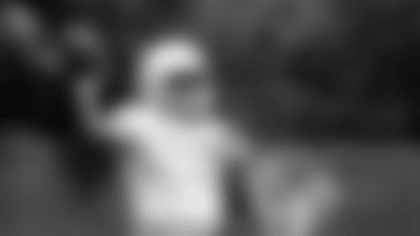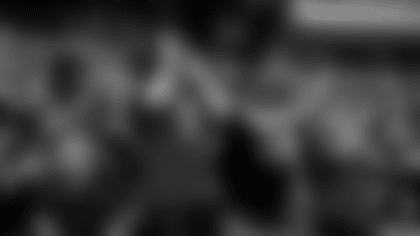Texans strength and conditioning coach **Dan Riley** writes his popular Fitness Corner column for HoustonTexans.com. Riley and assistant
strength and conditioning coach **Ray Wright** will continue to post selected answers to your questions throughout the year.
Join in by shooting over an e-mail to **fitness@houstontexans.com**.
Here's Dan...
A special thanks to Seth Payne for demonstrating the exercises in this installation of the Fitness Corner.
Seth just finished his Monday workout the day after the Titans game and was willing
to take some extra time to help us out.
I have heard from a couple of sources lately that it is not good to perform the lat pull-down behind the head. Is there any truth to this or is this just an opinion based on someone possibly injuring themselves while trying to lift too much weight and not maintaining proper form? I am currently doing it both ways and would like to know the advantage of each.
-- Jimmy Owens
During my tenure with the Redskins I received some negative information regarding exercises performed behind the neck, specifically the lat pull-down and the seated press. These were exercises we incorporated into most of our upper body Redskins routines.* *
I gathered as much information as I could find and then met with our medical staff. Everyone agreed that these exercises can cause structural damage to the rotator cuff and should be removed immediately from the program. The damage is accumulative over time. I posted this information for our players to read and apologized for my lack of awareness.
In their book "The 7-Minute Rotator Cuff Solution" Horrigan and Robinson explain the accumulative negative impact that can result from performing the following three exercises; seated press behind-the-neck, behind-the-neck pull-down, and upright row.
Performing the overhead press behind-the-neck and the pull-down behind-the-neck requires significant external rotation of your shoulders and full scapular adduction. You reach this position by pulling your shoulders backward similar to a soldier standing at the position of attention.
Horrigan and Robinson state, "Your external rotators have to work really hard, pulling against the tight internal rotators, just to get you in position for the exercise. This strain, plus the strain of having to work against the resistance imposed by the weight, is too much to ask of the rotator cuff – over time, it may strain, inflame, become fibrous, and weaken."
How many shoulder injuries have already occurred on the playing field that might be traced to the gradual soft tissue and joint deterioration that is accumulative from performing the press and pull down behind-the-neck? I do not know, however I am not willing to jeopardize the short-term health of our players.
How many athletes after their playing days are long over, begin to experience shoulder problems that may be directly attributed to the strength training exercises they performed when they were younger? Again I do not know the answer, but I am not willing to jeopardize the long-term health of our players.

After eliminating the behind-the-neck exercises from our program, I contacted our equipment manufacturers to discuss the modification of our overhead pressing equipment. Eventually this was accomplished.
In our facility the Texans have a variety of overhead pressing movements to choose from. Each of our overhead pressing movements is designed to perform the exercise in front of the body. Observe Seth demonstrating the Avenger Seated Press (1 | 2) and the Hammer Isolateral Seated Press (1 | 2).
In the past our players performed the overhead seated press with dumbbell at a ninety degree angle. Our players currently perform this exercise at less than ninety degrees.
We have a variety of lat pull-down machines for our players to choose from. Depending upon the equipment used, our players perform all lat pull-down exercises in front of the body using one of the following grips; underhand grip, overhand grip, parallel grip (1 | 2).
There is no advantage for performing the seated press, or the lat pull-down, behind the head (1 | 2). The potential risk of the structural integrity of the shoulder capsule far outweighs any advantage for performing either of these two behind-the-neck exercises. A disadvantage of the wide grip lat pull-down is a reduction in range of motion for the lats. Range of motion for the lats is increased as the grip is narrowed.
It is the responsibility of all coaches to eliminate any exercise that may compromise the physical well-being of an athlete during his/her playing days. We must be concerned for the well-being of our players when they compete as athletes and also during their adult life as a non-athlete.
While with the Redskins our players also performed the upright row (1 | 2). This exercise was performed in our neck sequence listed below:
- neck flexion
- neck extension
- lateral flexion right
- lateral flexion left
- shrugs (followed immediately by the upright row)
6. upright row
The author's of The 7-Minute Rotator Cuff Solution feel so strongly about the negative impact of the upright row, they post a "Training Alert" regarding this exercise in their book.
They state, "One exercise you should eliminate from your weight training program is the upright row. This exercise places the shoulder in internal rotation as the arm is raised, a position that does not allow sufficient space for the greater tubercle to clear the acromium."
Proper form requires pulling the elbows high. According to the authors this simply increases the degree of internal rotation and magnifies the danger of impingement. The final word from Corrigan and Robinson regarding the upright row? "Upright rows accelerate rotator cuff degeneration."
My number one responsibility to our players is injury prevention. I cannot incorporate an exercise(s) that contributes to gradual joint erosion. Our players do not perform the upright row, the behind-the-neck press, or the behind-the-neck pull-down.
Jimmy your concern must not be how you feel today, but how your shoulders will feel as you grow older. You may be doing gradual damage today that results in shoulder problems later in life. I suggest you begin performing all overhead pressing movements in front of the body, all lat pull-downs in front of the body, and eliminate the upright row.
Horrigan, Joseph, Robinson, Jerry, The 7-Minute Rotator Cuff Solution, Health For Life, Los Angeles, California, 1991













